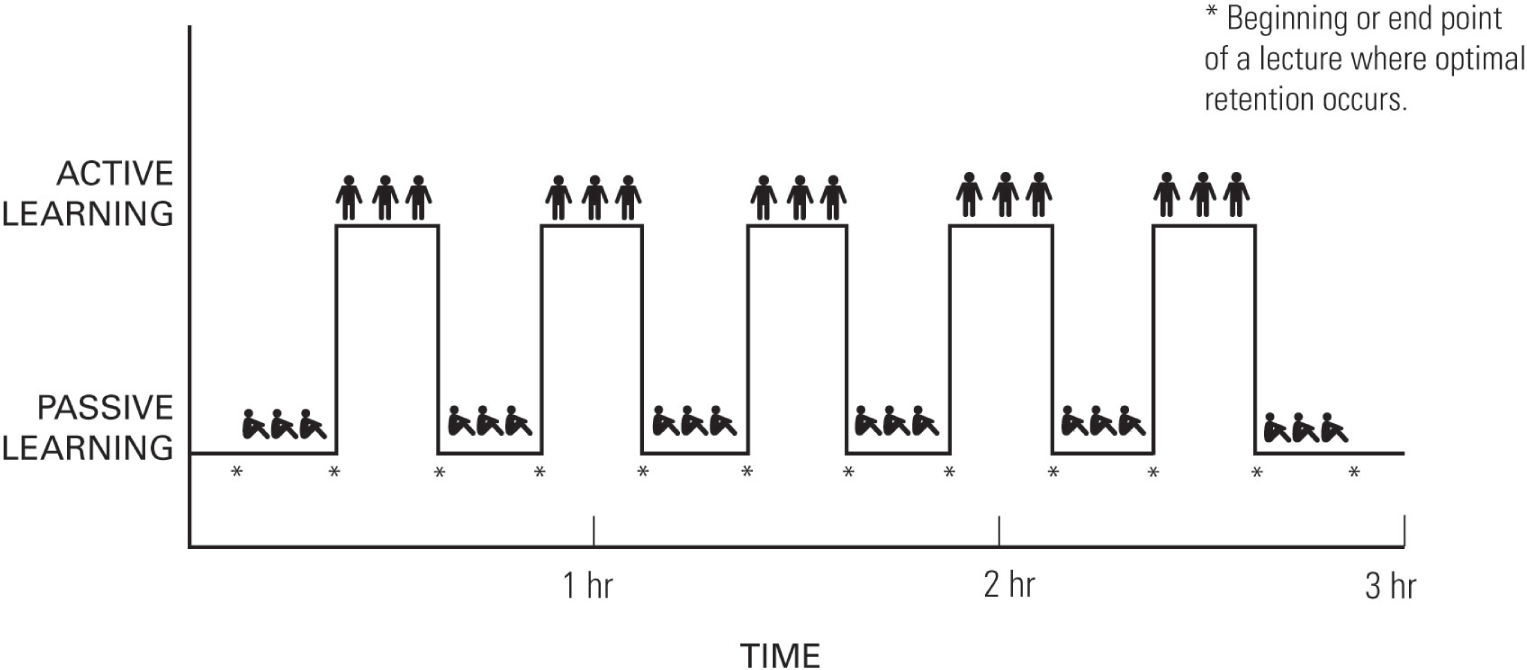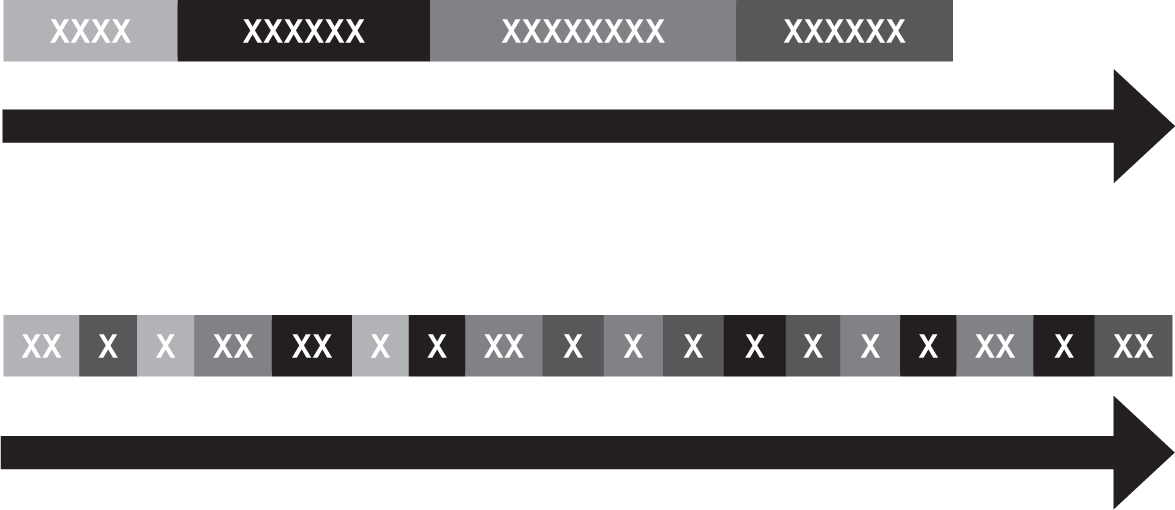2
Effective Technical Training
 What’s Inside This Chapter
What’s Inside This Chapter
This chapter describes researched techniques available to you to create effective technical training. Specifically, it defines and explains uses for:
• active and passive learning
• variety, differentiated instruction, and varied practice
• chunked and spaced learning
• scaffolding and frameworks.
There is one worksheet that the end of the chapter that serves as a checklist.
2
Effective Technical Training
What does effective technical training look like? This question perplexes many technical organizations. What form should our learning programs take to equip a technical workforce to do its job? Turns out, it’s a mix of a lot of things.
Active and Passive Learning
We all remember the “100-percent lecture course”—that mind-numbing classroom experience in which a professor droned on for hours and the only break in the monotony was the clicking of a PowerPoint slide or the ticking of the slowly moving wall clock. Sadly, many technical training courses mirror this experience.
There is a myth that won’t go away: that telling equals training. However, there is a difference between a learner listening to information and a learner actually acquiring knowledge (Hannum 2009). The act of sitting in a classroom and listening to or observing a class is called passive learning. Active learning is the opposite. Active learning involves participation in activities and compelling learners to engage in the subject matter itself. Examples of active learning include completing a worksheet, participating in class discussion, and working through a simulation. The consensus of the training industry is that effective training courses incorporate active learning principles.
 Basic Rule 2
Basic Rule 2
Active learning is anytime your learners are held accountable for doing something. Passive learning means that your learners sit, listen, and observe.
Lecture can be useful and does have its place in training, but lecture tends to be grossly overrepresented. When you include a passive learning element such as lecture or direct instruction in your course, you must manage it properly and ensure its usage is appropriate. The next section explains why.
Incorporating the Primacy-Recency Effect
In 1962, psychologist Bennet Murdock conducted an experiment in which he gave participants a list of items to memorize. When Murdock later asked these participants to recall the items on the list, he discovered an interesting phenomenon. Across the board, participants tended to remember the same items from the list. Specifically, they tended to remember items at the beginning and the end of the list, with their recall of items in the middle tapering off. This effect, known as the serial position effect, or primacy-recency effect, is of particular interest to those who develop technical training.
To best benefit from the primacy-recency effect in your course design, abstain from including long, drawn-out class lectures. To give learners the best chance to remember something in a class, limit lectures to short segments and provide activities or breaks in between. These breaks in the lecture function as starting and stopping points, or beginnings and endings, which will “stick” in learners’ minds more effectively than if the same information were delivered in the middle of a single, long lecture.
Consider this example. With a three-hour lecture that includes no activities, learners are given only one beginning (primacy effect) and one end (recency effect) to remember information. Thus, learners have only two chances to maximize their retention (Figure 2-1). If, however, that three-hour lecture is roughly broken into half-hour segments interspersed with activities, learners are given six beginnings and six ends, or a total of 12 opportunities to maximize retention (Figure 2-2). From this example, it is clear that by segmenting a lecture with activities, learners receive more beginning and end points to prompt information recall.
Figure 2-1. Straight Lecture

Figure 2-2. Lecture Broken Apart With Activities

 Think About This
Think About This
Plotting active-passive learning is a good way to visualize the structure of your training class. You can see exactly where you are complying with training best practices, and you can see areas where you may need to do some work (Figures 2-3 and 2-4).
Figure 2-3 is a plotted-out example of “Death by Lecture.” The vast majority of the class is passive (not to mention there isn’t even a restroom break in the morning). There is also little variety of instruction.
Figure 2-4 depicts a class that has a better mix of active and passive learning, although there are still passive chunks that are too long.
Figure 2-3. Class Summary View Example 1

Figure 2-4. Class Summary View Example 2

Guided Discovery-Based Learning
You may be asking yourself, “Is passive learning even necessary? Can’t we just have a 100 percent active course?” Consider discovery-based learning. Discovery-based learning involves “minimal teacher guidance, fewer teacher explanations, solving problems with multiple solutions, use of hands-on materials, and minimal repetition and memorization” (Wikipedia). Sounds pretty good, right? Conventional wisdom might support the idea that this is a good way to train and learn.
 Basic Rule 3
Basic Rule 3
Passive learning, sometimes referred to as direct instruction or lecture, has its place in training. Direct instruction can make learning more efficient, but when it is overused, it is not effective. The length of passive learning allowable is based upon the type of training intervention happening.
Unfortunately, a meta-analysis done by researchers from Kingston University, the College of Staten Island, and the Graduate Center of City University of New York found that discovery-based learning was not effective (Alfieri 2011).
And this does make some sense, especially when considering technical training. For example, a person with no prior technical experience could spend 10 years in a shop and, just by being around the equipment and tinkering, could maybe figure out how the tool works and even how to maintain it. But maybe not. That person would likely require some hints and explanation from an expert about how the tool components function and operate. Still, even if one could organically learn by oneself, does a business really want to have a 10-year training program? Probably not.
So, is this a reason never to pursue discovery-based learning? Well, there is more to the conversation. There is something called guided discovery-based learning that is effective. Guided discovery-based learning still includes aspects of solving problems with multiple solutions and hands-on materials, but it is done with periodic and consistent points where an expert provides guidance and support to learners toward specific learning outcomes. Returning then to our question, “Is passive learning even necessary?” the answer is yes. Passive learning, or direct instruction and expert guidance, does have an important purpose. Keep it; just don’t overuse it.
 Noted
Noted
Passive learning does not automatically mean PowerPoint. Passive learning can be a debrief on a whiteboard, a video, an animation, or even a visual demonstration. By definition, passive learning means any type of learning where the learners are not accountable for any action other than observing or listening.
 Think About This
Think About This
Here are two frequently asked questions about active versus passive learning.
Does it matter if you start or end with active or passive learning?
The biggest gain is from the frequent switch between active and passive. So, you could start or end either way. However, as a rule of thumb, start with an active session near the beginning and then end with passive. Starting a session with active typically tends to be good because you can break the ice, allow learners to meet their peers, and so forth. Ending with passive is also a good practice because you are in control of the final message of the course8 (which is strong, as we know from the recency effect).
Does the ratio of active and passive learning have to be equal?
No. If you have 12 minutes of passive learning, it doesn’t mean you must have exactly 12 minutes of active learning to balance it out. The active learning can be longer or shorter than this. The rule is that the active learning moment has to be something that breaks up what’s happening in the class. For example, an instructor could be giving a lecture on pipe fatigue or elastic deformation. Ten minutes into this lecture, the instructor could pass a paperclip to each learner and ask them to straighten it. After the learners do this, the instructor could ask the learners to put the paperclip back into its original form. Of course the learners won’t be able to do this, and this experience with the paperclip can be related to the phenomenon that occurs when there is pipe stretch and elastic deformation. This entire paperclip activity takes 60 seconds to complete, but it is an example of an “active moment” that helps to break apart the passive lecture. There is a caveat here; the reason the active and passive switchover works is because the brain wants variety when learning. Small activities like the paperclip example are appropriate, but they are not able to solely substitute for longer activities like case studies, worksheets, or group projects.
Closely related to the principles of active-passive learning and guided discovery-based learning is the idea of including variety in instruction, which is explained next.
Variety, Differentiated Instruction, and Varied Practice
Imagine a course structure of lecture, calculation, lecture, calculation, lecture, calculation, lecture, calculation, lecture, calculation, lecture, calculation, lecture, calculation. While this course structure does utilize an active-passive course design, it is still boring.
Aside from boring, such structure is not using best practices of differentiated instruction. Differentiated instruction is defined as providing “a range of different avenues for understanding new information” (Wikipedia). You can think of this simply as adding variety to your instructional plan. Because, fundamentally, our brains want variety when we are learning. This “variety” can take many forms, including the idea of varied practice. As Professor Thad A. Polk, of Carnegie Mellon University, concluded, learners who solve a variety of different problems are better suited to perform in novel situations (Polk 2018). This means when you are creating examples, case studies, and other activities, you should be trying to find different situations to test your learners in different contexts.
Use Cumulative Testing
Testing works. Learners don’t necessarily like it, but testing does work. There is something about not just learning, but also having to recall, that is thought to make testing so effective. Cumulative testing is even better because it provides multiple touchpoints and repetition for all course topics (Pasupathi 2013).
Highlight the Unusual
In her book Now You See It: How the Brain Science of Attention Will Transform the Way We Live, Work and Learn, Cathy Davidson describes attention blindness in this age of technology, and explains that to truly grab attention, we need to solicit the compelling or unusual. Barbara Oakley, author of A Mind for Numbers: How to Excel at Math and Science (Even If You Flunked Algebra), agrees. Finding unusual stories, facts, examples, statistics, analogies, and metaphors for your technical topic can be beneficial. It isn’t always easy, but any time you can find the unusual or unexpected within your training, it is typically good for your learners.
Use Analogies and Metaphors
Have you ever thought about how an Oreo is similar to the layers of the human skin, or a how a paperclip is related to pipe fatigue? You might think about something like this if you incorporate analogies or metaphors into your training.
Analogies and metaphors are a way of relating existing knowledge to new, technical knowledge. This is especially helpful for helping novice target audiences grasp a technical concept in an out-of-the-box way. As you tap into their existing adult knowledge you relate it to new knowledge in an interesting fashion.
Image the comparison between what happens in a recycling center to what happens to food during the digestive process. During the digestive process, food travels through the intestines. The intestines absorb the good nutrients and then dump the rest. In a recycling center, as garbage passes through a conveyer belt, workers pick out the recyclable materials and discard the rest. A new learner may not know all the steps involved in a recycling center, but probably has general working knowledge of the basic steps of the digestive process, and so can learn something new by comparing it to something known.
Use Stories
One of myths debunked in Clark Quinn’s Millennials, Goldfish & Other Training Misconceptions (2018) is that adults have the attention spans of goldfish. We know this can’t be true because we’re easily able to sit through three-and-a-half-hour movies with rapt attention. Some of the reason for that is good storytelling. Author Paul Smith, in Sell With a Story: How to Capture Attention, Build Trust, and Close the Sale, talks about the great power of storytelling in context of interpersonal communication and sales. There is an application to technical training. Talking about technical topics in the context of a story, or a single case history or multiple case histories, is a way to add learner interest, attention, and real-world application to your technical training.
Remember “What’s in It for Me?”
Motivation should play a key role in your learning strategy. As Dr. Raymond J. Wlodkowski (2004, 2008), a leading researcher on the impact of motivation in learning, explains, to promote attention, learning, and retention, focus on thinking about the various motivations that are at play with adult learners. This goes into ideas like “what’s in this for me?” or WIIFM. That is, how will learning this technical topic affect the learner personally? What are the benefits?
Technical training is actually similar to persuasive speaking. A speaker tries to get an audience to take an action, and a technical trainer tries to persuade people to change their behavior to perform a technical task or incorporate a specialized best practice. As such, motivation is a critical factor in technical learning.
Include the “Why” Along With the “What”
Another strategy related to motivation and technical training effectiveness to include the reason why the information is important within your program. In technical training, trainers will often tell learners the “what” without going into the “why.” Trainers tend to explain tasks, processes, checklists, and so forth but don’t necessarily explicitly go into why those things matter.
But the “why” is important. For example, let’s say you are providing training on the volume of a cylindrical tank as it is related to a hydraulic system storage. As part of this training, you may provide the formula for the a volume of a cylindrical tank and stop there, assuming learners understand the importance of this information.
To be truly effective, training should not stop with formulas, theories, or definitions. Trainers should answer the question, “why do we care?”
In the cylindrical tank example, you might answer the “why” question by explaining that “tank construction can affect air release, which means hydraulics can be less reliable and have poor performance. It could also be related to reduced viscosity and unnecessary wear on the system, especially when paired with Hydraulic Fluid B.”
By including the “why,” you are embedding the real-world context into your learning. This makes learners sit up and say, “Oh, maybe this training does have a point, and maybe it’s relevant to me.” Theory, formulas, definitions, and concepts should always be followed by “why do we care?”
Chunking and Spacing
A discussion of effective technical training isn’t complete without getting into the ideas of chunked and spaced learning. Consider these two different curriculum structures (Figure 2-5).
Figure 2-5. Chunked and Spaced Learning

The top example is organized by tool. You cover tool 1 first, then tool 2, then tool 3, and so on. The bottom curriculum example is all mixed up. You start with tool 1, move on to tool 2, return to tool 1, then move to tools 3 and 4, and then back to tool 2, and then back to tools 3 and 4. Which curriculum structure would you want?
It is a tricky question. The top curriculum example uses appropriate chunking, or logical packaging, of related technical topics in an easy-to-follow structure. The bottom curriculum example uses spaced learning, which is one of the most widely accepted practices based on learning-methods research.
In practice, chunking looks like a logically organized course, divided up into meaningful, easily recognizable sections. People typically remember concepts, not rote facts. Chunking is similar to a summarization of a topic. “Chunks” can be thought of as headlines for content. They are ways to package ideas so that less cognitive effort is required and learners can squeeze in more information. Chunks free up part of your working memory to bring in new information. When you think about technical training—whether it’s for microlearning, on-the-job training, virtual learning, instructor-led training in a physical classroom, and so forth—think about these chunks as concise learning segments.
By organizing content in chunks, you are guiding learners to the appropriate way to think about your technical topic.
 Think About This
Think About This
A curriculum can be composed of a multitude of microlearning points woven together. Think of training as broken down into 10-15 minute segments. What can you teach within each particular segment?
One of the most accepted methods studied by learning research is spaced learning. Spaced learning includes multiple touchpoints on important concepts that build throughout the curriculum. Spacing learning means that we bring up the same topics multiple times throughout the course. This repetition of topics aids in cementing the information into our learners’ brains.
So, do you want chunks or spaced learning? Returning to the previous question about which curriculum structure is better—one that is logically ordered, or one that utilizes spaced learning principles—the answer is that both have benefits. The benefit of the chunked, logical format is that it is easy for the learners to follow. It assists in packaging concepts for learners. A clear organization also allows the learner to be able to see the context of the topic being covered in a global sense. On the other side, spaced learning includes multiple touchpoints of important concepts to promote retention.
 Basic Rule 4
Basic Rule 4
Create a spaced learning structure that is as logically chunked as possible.
How do you reconcile these? There will be trade-offs, and it can make arranging a technical course less straightforward. The science—and art—of technical training is figuring out how to keep the feel of an organized curriculum while still spacing your critical topics. For now, just remember: we want a spaced learning structure, but we want it to be as logically chunked as possible.
Activating Previous Knowledge Before or During New Learning
When considering how to handle repeating spaced material in a curriculum, it is important to consider how learners activate prior knowledge and experiences.
Complex technical training builds upon itself. Basic concepts or procedures are learned and then expanded upon in later training. A famous study by J. Bransford in 1972 demonstrated this. In Bransford’s study (which has been repeated in different forms up to the present day), a control group was asked to read a vaguely written passage. Then, that group of participants was asked to write down the number of ideas they remembered. Most remembered about three ideas.
The second group had a different experience. Before they read the same vaguely written passage, they were given context about the passage; they were told the passage was about doing laundry. These participants remembered about double the ideas from the first group—or about six ideas. The context helped, and it showed.
Interestingly, there was a third group tested in the experiment. This group was given the passage to read, and after reading the passage, they were told that the passage was about doing laundry. It was a big surprise when this third only remembered an average of three ideas—the same as the first group. It was as if the participants had not been given any context at all. Activating prior experience after learning didn’t have an impact (Figure 2-6).
Figure 2-6. Activating Prior Knowledge

The takeaway from this is that when designing courses, always activate prior experiences or prior related technical knowledge before or during relevant lessons containing new material. Activating that knowledge after doesn’t have the same impact.
 Think About This
Think About This
A way to activate prior knowledge during instructor-led training is simply to ask learners what they already know about a topic before you start covering it. For example, you might say, “Today we are covering hydraulics. What do you already know about hydraulics?” or “Today we are covering the reporting section of the software. What information do we already know is included in this report section? Why is this relevant?”
Scaffolding
Scaffolding allows learners to gradually and continually be challenged. You are providing them instruction, broken into chunks, that is just out of their reach (not drastically, but just barely out of reach). With scaffolding, learners are periodically provided with more assistance, then that support structure is gradually and systematically reduced, learning continues, and the learner becomes more advanced.
 Basic Rule 5
Basic Rule 5
For prior knowledge to be beneficial, it must be activated before or during the process of learning new material. After does not have the same effect.
For example, scaffolding supports the idea of walking through a problem first before asking learners how to solve it on their own. Learners might be asked to focus on why the solution steps occur in that order and how they are interrelated. Then, for the second problem you could have the learners solve the question on their own, but with the general solution steps provided. For a third problem, the learners could be asked to solve the problem without any additional information provided. This systematic approach of gradual complexity of learner tasks is an example of scaffolding.
Identify and Stress a Framework
A framework is a way to think about your technical topic, providing a working mental model for the concept. While it is related to the idea of chunking, a framework is also something that you will want to repeat and space throughout your curriculum.
During technical training, there are tons and tons of details to remember, but if learners can just remember the framework, even if they forget 90 percent of the small details, they are more likely to make better-educated decisions.
Your framework may be a word or a catchy phrase, or it can be a graphic, chart, or other visual. A framework can be something like “when in doubt, check the procedure out,” or “always open one valve before closing another.”
For example, imagine there is a course on positive displacement motors. In this course, there are hundreds of little tidbits of information and lots of PowerPoint slides. There are too many details for learners to remember, but if they just remember the framework of Pressure=Power=Performance, even if they forget one or most of the small details, they are more likely to make appropriate decisions.
One way to identify the framework is to think about your content and answer this question: “If your learners could only remember one thing about your content, what would it be?” The answer should point you to your framework.
You should refer to your framework wherever it is relevant in your curriculum or course. Use the same font or give the framework consistent branding so that it is quickly recognizable. For example, in the positive displacement motors class, the Pressure=Power=Performance could be given a different font, color, and look from the rest of the presentation and it could be flashed on a slide (even if it is off to the side) many times throughout the course.
There can be more than one framework defined during a course. As a general rule of thumb, there could be a framework defined for each major topic or important concept.
Getting It Done
This chapter described many different research-based methods you can use to improve the quality of your technical training. Effective technical training includes a mix of active-passive learning that provides variety, spacing, and chunking. Effective training also answers the “what’s in it for me” and includes the “why” along with the “what.” Use Worksheet 2-1 to ensure you’re incorporating all the elements you need.
Worksheet 2-1: Checklist for Technical Training
Does my training address the following:
❑ Active-Passive Learning
❑ Variety/Differentiated Learning/Varied Practice
❑ Spaced Learning
❑ Chunking
❑ Cumulative Testing
❑ Analogies/Metaphors
❑ A Way to Highlight the Unusual
❑ Stories
❑ “What’s in It for Me?”
❑ The “Why” Along With the “What”
❑ A Framework
❑ A Way to Activate Prior Knowledge Before or While Learning New Material
❑ Scaffolding